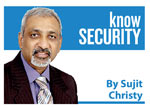Security predictions for 2016
View(s): Computing has increasingly become pervasive and enhanced almost all aspects of personal life and business. This has created more opportunities for innovation and introduced more vulnerability. Technologies such as sight, sound, and touch have enabled users to experience the world differently and interact with it and with each other in new ways. Everyday objects such as mobile phones and TVs have become smarter and connected. Computing is becoming an extension of an individual thus making the environment smarter, contextually aware and better connected. This is leading everything to change.
Computing has increasingly become pervasive and enhanced almost all aspects of personal life and business. This has created more opportunities for innovation and introduced more vulnerability. Technologies such as sight, sound, and touch have enabled users to experience the world differently and interact with it and with each other in new ways. Everyday objects such as mobile phones and TVs have become smarter and connected. Computing is becoming an extension of an individual thus making the environment smarter, contextually aware and better connected. This is leading everything to change.
Businesses have started to build deeper real-time connections to collect and selectively share vast amounts of data with their suppliers, partners, governments and customers. The value of stored and in-transit information has risen rapidly, creating new markets, thus a need to securely connect devices, deliver trusted data to the cloud, and derive value through analytics. The value of information has attracted the attention of adversaries to look at new ways to steal, leverage and benefit from it.
Adversaries have mostly been organised criminals and other criminals, hacktivists, nation-states and others – not necessarily seeking direct financial gain. However, as we look ahead to personalised and consumerised cyber-attacks, adversaries may also include a competitor, political opponent, spouse, neighbour or other personal opponent. Security investments, based on a checklist of technology required to meet compliance, have been failing to address underlying or existing vulnerabilities. The year 2015 experienced several data breaches, rapid growth of unknown malware and the exploit of vulnerabilities in platforms such as Android and iOS. They continue to remain a significant threat today.
Hackers will continue to find creative ways to attack networks. But as the year winds down, it’s time to reflect on what we learned and start focusing on the new challenges and opportunities that await us in 2016:
1. Hackers will not only customise malware to memory-resident or file-less malware but they will increasingly use sophisticated phishing and social engineering tricks to gain access to sensitive data. Ransomware will transition into other platforms such as medical devices, Wearables and Internet of Things (IoT).
2. Traditional sandboxing will no longer protect against the growing malware landscape. More businesses will turn to advanced threat prevention, such as CPU-level sandboxing, which will become more common as it is the only advanced solution that can detect and protect against evasive, unknown malware and zero-day attacks.
3. There has already been multiple high-profile vulnerabilities discovered this year and we expect that number of mobile vulnerabilities will only grow in 2016. Cybercriminals may set their sights on novelties like alternate payment systems, such as ApplePay and AndroidPay, whose increasing rate of adoption would offer a new means of immediate monetisation – Pickpocketing the mobile wallet.
4. IoT will continue to emerge and businesses will need to think about how to protect their smart devices and prepare for the wider adoption of IoT.Similarly, the wearables like smartwatches will make their way into the enterprise. This will also introduce new security risks and challenges as wearables can be hacked to capture video or record audio. As infrastructure ages, challenges posed by using obsolete connected technology will continue to grow.
5. This year saw the beginning of car hacking. Modern cars are featuring more gadgetry and connected systems and this will make automobiles, including trains and planes, vulnerable to today’s threats and attacks.
6. Organisations are moving to virtualised environments that are complex and create network layers, which can become an attack vector. Virtual environments will require new approaches to network security. Forgotten ongoing maintenance will become a major problem for defenders as maintenance costs rise, manageability falls and manpower is limited
7 New operating systems such as Windows 10 and iOS 9 were launched this year. Hackers will take advantage of attacking these new operating systems because updates are more frequent and users are less familiar with the environments.
8. Backup and recovery time will be a hurdle for the enterprises with the explosive growth of structured and unstructured data. The increasing reliance on cloud infrastructure as an integral part of business operations means that much more of the organisation’s confidential data is off-premises. Encrypted data backups and agent-less cloud-based replication will become the norm for data security.
9. To protect against advanced threats, security professionals will increase their reliance on centralised security management solutions. Consolidating security provides an effective way to cut complexity and make for easier management.
10. The shortage of cyber-security talent will be a huge issue over the next few years. These security jobs will be filled by Managed Security Service Providers.
I have endeavoured to anticipate as many (next) wave of threats as I can and hope organisations can use the information herein to stay ahead of the evolving tactics of cybercriminals. (The writer is a Governance, Risk and Compliance professional and Director at Layers-7 SeguroConsultoria (Pvt) Ltd. He is the founding member and Secretary of the (ISC)2 Chennai Chapter, Founder/President of Information Security Professional Associates (iSPA) and a board member of the (ISC)2 Colombo Chapter. He can be emailed at sujit@layers-7.com)


